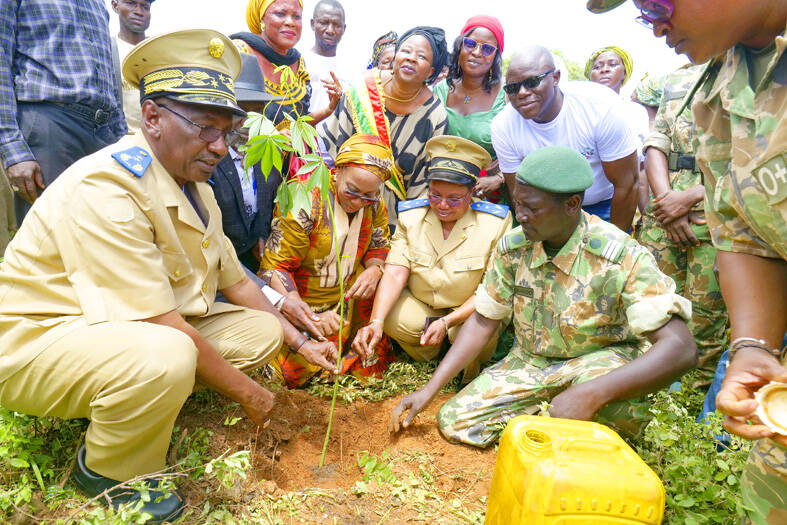AP, BAMAKO
After years of serving as Mali’s minister of the environment, Aida M’bo now spends her time planting trees in a fight that many in the arid west African country acknowledge they are losing.
“Deforestation is an important issue in Mali,” M’bo said, standing in front of the Zamblara forest.
For decades it has been classified as protected, but like many forests in the vast Sahel, it could be wiped out.

People plant trees in the Zamblara forest in Mali on Oct. 2.
Photo: AP
“It is mainly due to the excessive wood-cutting,” M’bo said.
Even some of her fellow tree-planters that day were to blame. Salimata Diabate, who took part in the ceremony last month, lives nearby and sells firewood from the forest in the Sikasso region, long considered Mali’s breadbasket.
While Diabate expressed concern about the threats to Mali’s forests, she said people like her in the countryside have no choice but firewood for cooking.
“Things like cooking gas and solar panels are better, but it’s too expensive for rural women,” she said.
The loss of forests has become a pressing issue across Africa as the Sahara Desert continues to creep southward. Over the past three decades, nearly 20,000km2 of forest have been lost in Mali, according to environmental nonprofit Tree Aid.
M’bo’s nonprofit, Energia, is financially supported by the Great Green Wall, an initiative by African countries launched in 2007 that aims to plant trees in a nearly line about 8,000km long across the continent, creating a natural barrier to hold back the desert.
However, millions of the trees died as temperatures rose and rainfall diminished. As a result, only 4 percent of the Great Green Wall’s original goal has been met, and an estimated US$43 billion would be needed to achieve the rest.
In Mali, the initiative is facing an additional challenge: the population’s dependency on firewood.
Lassana Coulibaly, who lives in the town of Senou near the capital, Bamako, spends his days chopping up and reselling wood he buys from people who cut it from a nearby forest.
“This how we make a living on a daily basis,” he said.
He does not believe the forest will disappear.
A 2019 study by the African Energy Commission found that 64 percent of Mali’s total fuel consumption was of biomass, primarily firewood and charcoal for household use.
Despite being one of Africa’s top gold producers, Mali ranks among the world’s least-developed nations, with almost half of its 23 million population living below the national poverty line. The problem is worse in rural areas, where subsistence farming — many people’s only real option for survival — is threatened by armed conflict.
The country has been plagued by an insurgency fought by armed groups, including some allied with al-Qaeda and the Islamic State group, and two military coups since 2020.
Mali is also among several countries in the Sahel that have experienced record-breaking floods this year, with more than 1,000 people killed and hundreds of thousands displaced across the region.
Khady Camara, an environmental activist based in Senegal, said that forests can help to weather the effects of climate change by absorbing water to prevent floods, and by absorbing carbon that would otherwise end up in the atmosphere as part of heat-trapping gas.
“We need to give more priority to our forests, but we also need to set up new forests and give priority to natural regeneration,” said Camara, whose organization Vacances Vertes has planted 150,000 trees in Senegal.
She said the effects of climate change on the Sahel region can’t be overstated and the causes often come from far beyond the African continent.
“Africa produces only 3 percent of greenhouse gases. Ninety percent is from the West,” she said. “If we continue like this, I’m saying to myself that this will be the disappearance of Africa, and of Africans.”



